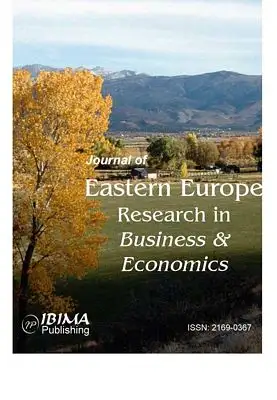Evolution of the concept of ecosystem
Although the phrase itself gained popularity in the 2000s of the twenty-first century, the idea of ecosystem in economic literature is not new. During the previous century, economic plans and employment policies in many nations around the world (such as India in the 1950s or Great Britain in the 1970s with the Bolton Committee Report) took into account the use of technologies that facilitate the development of new businesses. Some writers make reference to nineteenth-century economic theory and Alfred Marshall’s idea of clusters, or industrial centers, in their explanation of the theory of competitiveness. Marshall pointed out that the concentration of businesses in one location boosts output and enhances working conditions. The involvement of the public sector in building an environment and market institutions supporting individual entrepreneurship, and later entrepreneurship of small and medium-sized enterprises (SME sector), reached its highest level in the mid-1990s. Over time, the interest in increasing the level of small entrepreneurship was replaced by entrepreneurship with increased innovation and dynamic efficiency of companies. Combining the efforts of work and intellect provided new development opportunities not only for enterprises, but also for entire regions and countries. As part of new industrial relations, the competitive model of the industry, previously based on low labor costs, is changing towards the use of modern mechanisms of generating knowledge and advanced digital technologies. This involves the need to take actions that favor the sharing of labor resources, capital, knowledge and technology by all interested parties, i.e. universities, business, public administration (triple helix), media and civil society (quadruple helix) and the natural environment (quintuple helix) or rather its representatives (Carayannis, Barth, & Campbell, 2012, Carayannis 2022). This means the need to reconstruct ecosystems supporting entrepreneurship. The outline of the concept of modeling and creating ecosystems understood as systems supporting conceptual activities, diversifying and commercializing projects with various levels of innovation and technological advancement, means that the issues of ecosystem pillars, relationships, and value flow require a new approach. The literature on the topic has a history of referencingand comparing economic processes to the evolution of biological forms of living organisms (Blew 1996, Rothschild 1990, Malecki 2018). The fundamental functional unit of inanimate nature, living things, and their natural habitats that interact with one another is called an ecosystem. Accordingly, there are ecosystems inside ecosystems (for instance, a forest environment is animated by an aquatic ecosystem, and the two systems interact) (Clements, Pound 1898, Tansley 1935). Genetic information contained in DNA molecules forms the foundation of all life in the biological world. Technological information, which is the foundation of all economic life and may be found in books, blueprints, scientific journals, databases, and common knowledge, plays a similar role in the economic environment (Rothschild 1990, Rothschild 2004 p.335). The information contained in an organism’s genes, along with its interactions with competitors, predators, and prey, define it. Similar to this, an organization’s technology and its interactions with suppliers, customers, and rivals define it. According to Rothschild (2004, p. 213), organisms and organizations are nodes in a network of relationships. The spontaneous nature of entrepreneurship, on the other hand, arises from the subjective and practical processing of distinct and scattered knowledge, while the coordination of information flow among market participants stimulates the economic environment (de Soto, 2010: p.20).
In the 1960s, T. Levitt made a comparison between the life cycle of a product and that of a live organism in the field of management sciences in 1965. The biological life cycle of plants was mentioned in enterprise theory, and the industrial sector life cycle theory also made similar comments (Klepper, Miller 1995). The population theory was developed in the 1970s to explain the interactions between an organization and its surroundings (Hannan, Freeman 1977). Though it adopts the perspective of the environment rather than the organization, this theory is similar to the resource dependence theory in that it assumes that the organization depends on the environment for access to the resources required for operation (Hatch 1990, Caroll 1994). Dependency allows the environment to exert considerable influence over the organization. With the help of this capability, the environment can select the organizations that best suit its demands among a range of competing ones. According to the Darwinian principle, the most adaptive organizations will prevail in a challenging circumstance. This theory is predicated on the idea that organizations are fighting for their lives. According to population ecologists, groups that share a similar resource pool are dependent on one another in a competitive environment, and the patterns of mutual dependency that the group adopts have an impact on the success and survival of its individual members. Therefore, population ecologists research complete interrelated sets of institutions that comprise a population, such a population of daycare facilities, universities, etc. Institutional theory, which also uses biological sciences terminology and describes attitudes of copying actions, colors, or attitudes as isomorphisms, is worth mentioning in addition to the previously mentioned population theory and resource dependence theory (Czaja, Kafel 2022). Therefore, it can be said that an ecosystem from a certain set of random elements produces a system with a specific structure with certain processes taking place inside it. It should be noted, however, that the ecosystem is not simply the sum of the identities of the organizations that are part of the system. The identity of the ecosystem cannot be reduced to the individual, elementary identities of the ecosystem participants. However, there is a belief that the identity of the ecosystem significantly affects the identity of individuals in the population, i.e. individual members of a given system. Therefore, the evolving nature of ecosystems is noticeable, consisting in the gradual self-regulation of system participants. It is also worth noting here that the organization does not completely adapt to the existing environment, but co-creates it.The author who permanently introduced the concept of the business ecosystem and later the entrepreneurial ecosystem into the literature of economics and management is J. Moore (Moore 1990, 1996). Initially, he attributed the creation of the business ecosystem to endogenous forces (coming from within the company and its core business), exerting influence on the micro-environment as a result of extended activities and reaching through lobbying to regulatory institutions of the macro-environment (i.e. legislative and executive authorities, standardization bodies, certification bodies, and others shaping the conditions for conducting core activities, etc.). (Moore 1993). Over time, business ecosystems lose the identity of the company that initiated their creation, they interpenetrate each other, cross the traditional boundaries of industry, sector or specialization, and, as a result, there is a synergy effect and benefits from cooperation in the same environment. Companies that allocate part of their own revenues to investments and ecosystem infrastructure achieve additional benefits from the ecosystem, regardless of the scale of their operations (Moore 1996, p.20), are beneficiaries regardless of whether they are leaders or only cooperating organizations, benefit from cooperation among themselves, which are the effects of benefits and cooperation resulting from the links of infrastructure, transport, communication and joint activities on the market. The business ecosystem uses the economy of cooperation between entities and creates conditions for building value that would not appear in traditional distribution channels, and which were created thanks to the system of cooperation on the market between enterprises and organizations from various sectors. At the same time, it was noted that the ecosystem does not coincide with the traditionally understood sector, but creates an organizational hybrid of entities and relations, tailored to the needs of one enterprise, and over time other cooperating units (enterprises, institutions) became part of the resulting structure striving for homeostasis.. The ecosystem supports the creation of value that would not appear in traditional distribution channels, but which was created thanks to a system of cooperation on the market between companies and organizations from various industrial sectors (the ecologically inspired concept of an “ecosystem” of business contexts, referring to the concepts of “value chain” or “constellation of value” (Moore 1993; Normann and Ramirez, 1993, Moore 1996; 21). Analogous to biological life, ecosystems create interactions between entities and their environment, build market relationships – competition and cooperation, mimic ontological, physiological, and evolutionary processes, and are responsible for the resulting life cycles and the creation of product value (Moore 1993, van de Ven 1993, Stam 2009, Stam 2021). In economic life, one can observe dependencies between operating business entities and those operating in the sphere of administration, education, research and development and entrepreneurship support. They form groups of business organizations that create systems of cooperation between entrepreneurs and the environment in order to create new values (production and services) delivered to the market (Stam 2009, Stam 2015). In the concept of modeling the entrepreneurial ecosystem, some authors assume that entrepreneurship is a collective achievement that is based not only on the behavior of individual entrepreneurs, but requires many entrepreneurs to be involved and play roles in both the public and private sectors (m.in. to develop technical, communication, or industrial infrastructure that facilitates the implementation of innovations) (Stam 2021, van de Ven 1993). The conditions and factors offered by the capitalist system are incentives for innovation and entrepreneurship to “use new knowledge to create value” in the ecosystem. The emphasis on creativity is well placed, and it issues warnings against such incentive-damaging policies as high taxes on income and profits. Innovation and entrepreneurship are, after all, the real driving forces in any economy. “Innovative ideas become new methods and new equipment that push the boundaries of productivity. A company’s performance is limited only by its technology, and its technology is limited only by the ability of its members to work together as an intelligent, creative organization” (Rothschild 2004, p.185). The idea of the ecosystem has become the subject of economic policy as an institutionalized system of entrepreneurship support. Subsequent research work defined new concepts characterizing the entrepreneurial ecosystem (elements, dimensions, pillars, attributes and areas) until the development of a holistic concept of programming economic development and shaping entrepreneurial attitudes (Isenberg, 2011; Valkokari, 2015; Shwetzer et al., 2019; Theodoraki et al., 2022). The evolution of institution can faciliate market relations and a hospitable environment for cooperative solutions for economic growth (North 1990). Entrepreneurial ecosystems have been recognized as a mobilizing metaphor in the public and private sector, also bridging the boundary between the two: public institutions and enterprises (Stam 2018). Among these areas, which are to strengthen and make European economies more resistant to economic downturns after a period of economic downturn in the period 2020-2023, economic areas at the interface of several branches and sections of industry and services, currently called ecosystems (Ruohomaa 2022), have been distinguished. Their development in the future is to follow two main paths: technological and ecological with respect to technology cycle time (Lee, K. 2024).
Definitions and elements of the ecosystem
An entrepreneurial ecosystem is a well-known and intricate concept. Purpose, location, beneficiaries, dimensions, pillars (elements of the ecosystem), interactions, and result exhibit a lack of coherence in the definitions of this concept (Table 1) (Feld 2012, Brown, Mason 2014, Stam 2015, Malecki 2018, Shwetzer, Maritz, Nguyen 2019, Fredin, Linden 2020, Stam and van de Ven, 2021, Theodoraki, Dana, Caputo 2022). A novel and distinctive way to understanding and promoting growth-oriented entrepreneurship is provided to researchers and policymakers by a holistic or systemic approach to entrepreneurship. However, it is certainly challenging to comprehend these complex organisms due to the conceptual limits and lack of requirements (Brown, Mason 2017). Furthermore, the ideas of business, innovation, entrepreneurship, the knowledge and technology ecosystem, and industrial areas, clusters or innovation systems are used interchangeably, although they are not the same (Stam 2015, Malecki 2018, Spigel, Stam 2021).
Table 1: Definitions of the concept of ecosystem (business, entrepreneurship and innovation)
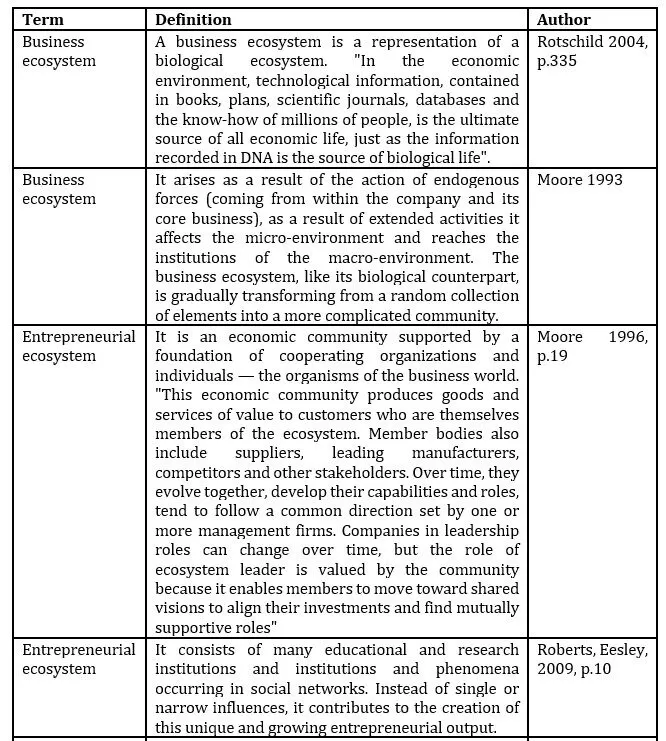
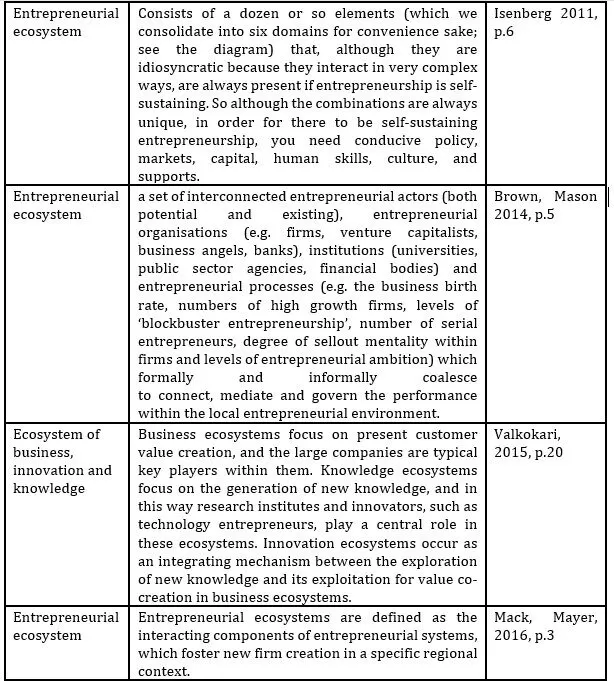
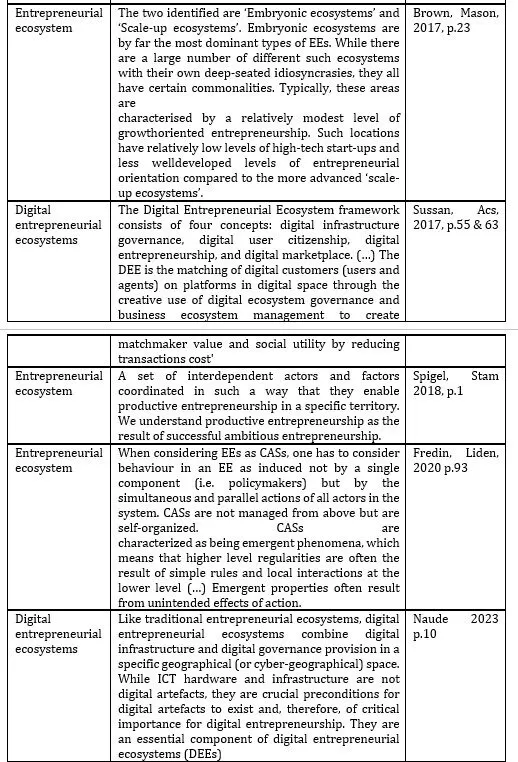
Source: Authors’ own study based on: E.J. Malecki, E. J. (2018). ‘Entrepreneurship and entrepreneurial ecosystems’, Geography compass, 12(3), p.3-21, Sussan, F. and Acs, Z. (2017). ‘The Digital Entrepreneurial Ecosystem’, Small Business Economics, 49, 55–73, S.Fredin, A. Lidén (2020). Entrepreneurial ecosystems: towards a systemic approach to entrepreneurship?’, Tidsskrift-Danish Journal of Geography, No 120(2) p.87-97 and Naudé, W. (2023). Destructive Digital Entrepreneurship. IZA – Institute of Labor Economics.
The broadest meaning is the concept of the entrepreneurial ecosystem – in the literature described by the abbreviation EE. The innovation ecosystem as an analogous concept to the entrepreneurial ecosystem has appeared in the literature in the context of planning and supporting economic development CIS (country innovation systems), RIS (regional innovation systems), as well as the development of sectors and branches of industry (sectoral innovation system). Nowadays, this concept is also referred to corporate innovation systems (corporation innovation system) in the organizational (innovation-friendly environment) and environmental sense as a set of enterprises, institutions, and research centers cooperating for the research, improvement and implementation of innovations (business accelerators, hubs, innovation centers, clusters, technology parks, incubators, start-up hubs, networks and research centers of new technologies) (Spiegel, Stam 2015, Ketonen-Oksi, Valkokari 2019, Granstrand, Holgersson 2020). Innovation-driven entrepreneurship model uses ‘innovation ecosystems’ and ‘entrepreneurship ecosystems’ (iEcosystems) framework interchangeably (Murray and Budden 2017). The majority of the research on entrepreneurial ecosystems up to this point has viewed ecosystems as constrained geographical areas with clear boards. However, the limits of entrepreneurial ecosystems have been expanded and muddled in recent decades by technology innovation and advancements in social relationships (such as online platforms, social media, and the sharing economy) (Muldoon, Liguori et al. 2022). As a result, the scope and effects of a particular environment are frequently understated in contemporary studies on entrepreneurial ecosystems.
Models of the entrepreneurial ecosystem
The lack of consistency in defining the domains (pillars, atributes etc.) of the ecosystem, the too broad definition of institutions and economic entities as elements of the ecosystem and the avoidance of indicating the roles of entrepreneurs in the ecosystem, as if the business ecosystem model could function without entrepreneurs, are pointed out by critics and authors of holistic approaches to the problem of creating an institutionalized support system for the intensity of entrepreneurship (Brown, Mason 2014, Shwetzer, Maritz, Nguyen, 2019, Theodoraki, Dana, Caputo 2022). However, all concepts include: leadership and policy, labour, capital, culture and supporting infrastructure. Several proposals of EE models can be distinguished in the literature, including: ecosystem domains by Isenberg (2010), ecosystem pillars by World Economic Forum (2014), Six+Six entrepreneurship ecosystem model by Koltai (2016), ecosystem attributes by Spigel (2017), innovation-driven entrepreneurship by Murray and Budden (2017), or entrepreneurial ecosystem model by Stam and Van de Ven (2021) (Jafarov, Szakos 2022), EEs as CASs (Fredin, Linden, 2020) and transformed EE model (Leendertse, Schrijvers, Stam 2021), and, lastly, the combination of the digital ecosystem and the entrepreneurial ecosystem (DEEs), two forms of entrepreneurship in the digital era (Susan, Acs 2017). E. Stam, a European researcher and scientist who started studying the elements (actors), conditions, and factors strongly influencing regional economic development, developed a model of regional entrepreneurship that is intriguing in this context. This model is called the decagon, or the diamond of regional entrepreneurship. Strong ties between educational and business services, innovation leaders, research and development, venture capital, demand, governance quality, innovation networks, and physical infrastructure ultimately result in the establishment of new businesses, as confirmed by the interdependencies among the components of the regional development ecosystem (Stam 2010). (Stam, van der Ven 2021; Stam, 2009). The original concept of the E.Stam ecosystem model was constructed through the critical research of the economic literature devoted to the modeling of entrepreneurial ecosystems, as well as the analysis and synthesis of work on the European economic development planning policy. According to Stam (2015), the entrepreneurial ecosystem consists of mutually reliant or cooperative groups of actors and factors that are controlled to allow for the generation of new value in the market, or aggregate value creation. The components of the ecosystem that E. Stam mentioned are the outcome of his research into other authors’ works and his shift from a micro- and mesoeconomic approach to a systemic approach, where his findings validated the close connections between business and educational services and other elements to strengthen the processes of creating new companies, creating business networks and productive entrepreneurship. The next stage in the development of his views is the concept of an entrepreneurial ecosystem involving groups of cooperating or mutually dependent actors and factors that are managed in such a way as to enable the creation of new value (Stam 2015). The conditions and factors of the ecosystem create opportunities to create new values in the market as a result of entrepreneurial activity and activities. Describing the pillars of the EE, E.Stam distinguished the systemic conditions of the ecosystem: networks, leadership, finance, talent, knowledge, support services and framework conditions: formal institutions, culture, physical infrastructure, demand, including: regulatory (political) framework and infrastructure (Fig.1), which could ultimately be assessed for efficiency and effectiveness (Stam 2018).
As a result of the search for the entrepreneurial ecosystem model, a concept was created that includes institutional arrangements: as initial norms and formal regulations, cultural and existing networks and social connections, which determine (P1) the use, combination and allocation of resource endowments: physical and financial resources, labor, talents, leadership, knowledge, service intermediation and affect the volume of demand (Fig. 1). The appearance and interaction of all these elements creates the ecosystem structure. Ultimately, the result of the emergence and functioning of an entrepreneurial ecosystem at the systemic and macroeconomic level is productive entrepreneurship (P2) defined as any entrepreneurial activity that contributes (indirectly) to the net output of the economy or the ability to produce additional output (Stam, van de Ven 2021). Productive entrepreneurship based on inventiveness and spontaneous innovation is limited by another type of entrepreneurship – unproductive, destructive and routine (P4), which does not contribute to economic growth; however, this division does not include a moral judgment, but only a contribution to building prosperity and welfare (Trubnikov 2021, Aeeni et al. 2018). Creative and productive entrepreneurship (P2) results from dynamic efficiency (DE), while unproductive, destructive, and routine entrepreneurship (P4) is the effect of static efficiency (SE) and x-Inefficiency (de Soto 2008). We can also say about inverse or negative dynamic efficiency (IDE). Innovation processes become a source of exclusive profits, they are the result of systematic research and development work on technological changes, guided by bureaucratic procedures by managers in significant enterprises (Baumol 1993, p.113). The advantages for industry and production increase with the speed at which innovations spread and diffuse. The inventiveness and spontaneous innovation that characterize productive entrepreneurship are constrained by other forms of entrepreneurship. Because of this entrepreneurship, innovation becomes a norm and innovation processes generate exclusive profits. According to J. Schumpeter, this kind of “innovation” is the outcome of methodical research and development on technological advancements, directed by managerial processes in major corporations. It does not originate from an entrepreneurial combination of factors of production. It would be more accurate to refer to such an “innovation” as a modernization of an earlier innovation (Baumol 1993). Entrepreneurship is accomplished by allocating resources that are either owned or organized from outside sources. Conversely, unproductive activity results in a decline in economic outcomes, indicating that the innovative system, technology, or procedure has slowed down operations, reduced the quality of the products, or worsened the economic results that have been attained. The term “systematic sabotage” refers to intentional actions that lower production efficiency (in the rare cases of monopolization or rationing) (Baumol 1993: 8). In the next installment of the modification and transformation of the EE model, cumulative productive entrepreneurship results in economic growth (P3), which is the desired result of any economic activity and they both stimulate the entrepreneurial ecosystem (P5) (Fig.1).
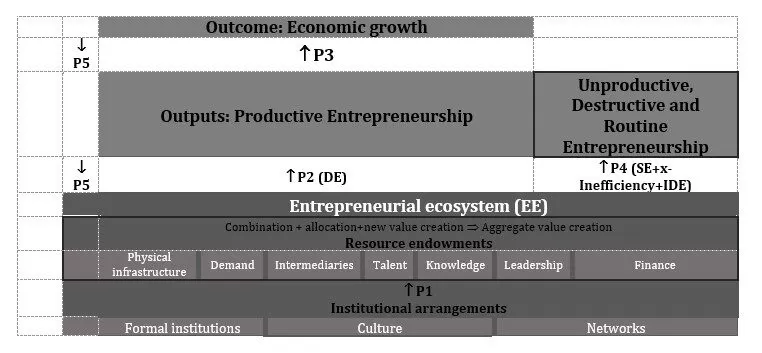
Fig 1. Elements of an entrepreneurial ecosystem model by E.Stam
Źródło: Authors’ own study based on: Leendertse J., Schrijvers M., Stam E., 2021. Measure Twice, Cut Once: Entrepreneurial Ecosystem Metrics, Research Policy, No 51. 104336. 10.1016/j.respol.2021.104336 and E.Stam publications.
According to researchers, the entrepreneurial ecosystem resulting from economic policies focused on economic development, built as a system of entrepreneurial value creation, can be measured by measuring all its elements (Stam 2009, Vogel 2013 a and b, Brown, Mason 2014, Stam, van de Ven 2019, Leendertse J., Schrijvers M., Stam E., 2021).
Identification of ecosystem elements and factors from the perspective of enterprises (empirical part)
Characteristics of the problem and assumptions of the research
Conclusions from the review of the literature devoted to innovation ecosystems and the implementation of modern solutions for production and services allow to identify issues that require further research on the ecosystem and to take into account changes in the natural and economic environment under the influence of the technological revolution. There is a lack of research on the impact of technology and digitization revolutionizing the speed, scope, and market relationships between ecosystem elements. It is also pointed out that the perspective of economic entities is not included in ecosystem models, mainly enterprises that create new entrepreneurial value on the market in order to meet the needs of buyers (individual and institutional). The aim of the article is to present the results of research conducted to identify the elements and factors of the ecosystem from the perspective of enterprises in Poland. The use of digitalization in the rationalization of structures and processes in enterprises is becoming an important source of their competitive advantage today. Digitalization creates the possibility of more effective integration of the enterprise with the environment, both closer and further. This often means the need to modify the business model of the enterprise towards “network logic, which currently provides greater development opportunities than the logic of value chains” (Szomburg et al., 2020). It is therefore important to increase the efforts of Polish enterprises for further digitalization and their potential in this area. This requires reforms, improving business conditions, encouraging investments in digital technologies, developing skills and modernizing infrastructure. Without such actions in the process of building a digital economy and society, it may significantly delay catching up with the European Union. The assessment of the level of digitization and the assessment of the areas of the entrepreneurial ecosystem in the surveyed enterprises will be presented in terms of sectors (by size of enterprises) and branches (by economic activity section). The computer-assisted survey (CATI) was conducted in 2022, just after the period of restrictions and closures of global economies caused by the coronavirus pandemic in 2020 and after the launch of the system of subsidies and financial support in the European Union countries. In Poland, three programs to support the financial liquidity of enterprises were launched under the name: Financial Shield 1.0 (in 2020), Financial Shield 2.0 (in 2021) and Financial Shield addressed to Large Enterprises (in 2021 and 2022). Due to the limitations of direct contact between people, including the movement of employees and customers, as well as sharp declines in the sales volume of enterprises, many of them decided to introduce remote work using modern forms of communication, meetings and performing professional duties. The degree of use of modern technologies and their integration in business activities is monitored in Europe by the Digital Economy and Society Index (DESI for 2022, Poland, p.13). In 2022, Poland ranked 24th among EU countries. It sets out the digital ambitions for the next decade in the form of clear and specific goals. The main goals of this programme can be summarised in 4 points: a digitally skilled population and highly skilled digital professionals, a safe and sustainable digital infrastructure, digital transformation of enterprises, digitalisation of public services. The programme’s goals have been defined in the key areas of DESI, which currently monitors 32 digital maturity indicators in four areas:
- Digital competences;
- Digital infrastructure;
- Integration of digital technologies (in the document “The road to a digital decade”, this area is called: Digital transformation of enterprises);
- Digitalisation of public services (Decision (EU) 2022/2481 of the European Parliament and of the Council).
In terms of the integration of digital technology in business activities, which allows for assessing the level of business digitalization and e-commerce, Poland ranks 24th among EU countries (Table 2). This DESI dimension includes indicators such as: using cloud solutions, engaging in electronic information exchange, using large data sets (Big data) and artificial intelligence (AI), and conducting ecological activities within ICT. According to data for 2022, 40% of Polish SMEs have achieved at least a baseline level of digital technology uptake, which is below the EU average of 55%. Polish companies are taking advantage of the opportunities offered by digital technologies and are also engaging in e-commerce. 14% of SMEs sold online and 5% sold cross-border to other EU countries. Advanced digital technologies are gaining popularity among Polish businesses: 19% of enterprises use cloud solutions (EU: 34%) and 32% use electronic information interchange (EU: 38%). Nevertheless, only 18% of Polish companies actively use social media, and 3% use artificial intelligence (AI) technology in their operations. At the same time, Poland declared the implementation of the program for the digitization of administrative contacts in the “Digital Decade of Europe: Digital Goals for 2030”. The report points to the need to step up efforts to achieve the 2030 Digital Decade target, which requires 75% of businesses to use cloud services, big data and artificial intelligence. Digitization and digital integration of business is a solution planned and programmed in the area of the economy, obligatory for many enterprises that would not introduce advanced technological solutions due to the costs of implementation, if it were not for the nature of regulations and system requirements.
Table 2. Integration of digital technology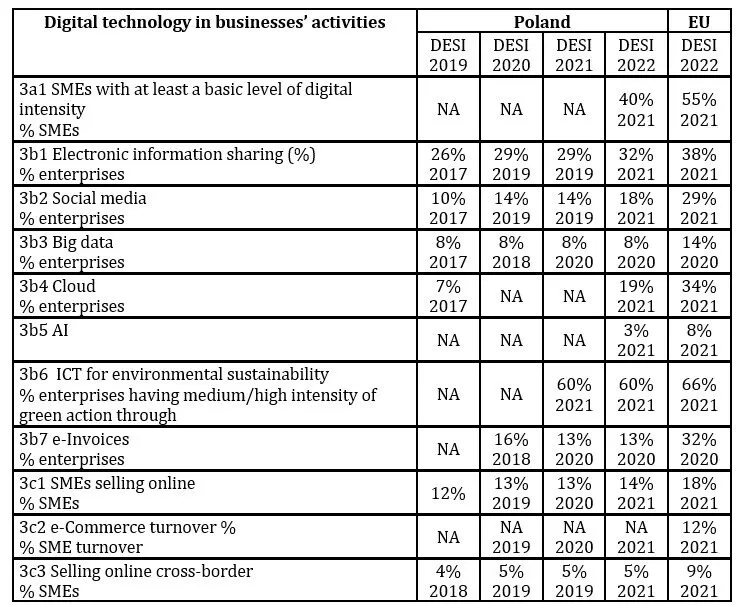
Source: Authors’ own study on DESI for 2022, Poland, p.13 and DESI for 2019-2021.
National surveys conducted on digitization in the SME sector in 2022 (Digitization of the SME sector in Poland, 2023) indicated that the cost factor is very important (indicated by 46% of the surveyed companies). The biggest barrier preventing SMEs from digitisation is the too high implementation costs. Key factors from the point of view of larger entities, such as legal uncertainty and chaos (29%), lack of competence of staff to introduce new solutions (19%), lack of knowledge about available tools in the field of digitization (18%), are less important in the SME sector. Almost 40% of the SME sector (mainly micro-enterprises) declare that they do not use any digital tools. In turn, nearly 13% of the same sector (including micro-enterprises) use advanced digital tools, cloud computing and artificial intelligence. The problem is therefore of a cost nature, although it is possible that smaller entities simply do not see the financial balance of the implementation of digital solutions in a slightly longer perspective (Digitization of the SME sector in Poland, 2023, p.16) and more than two-fifths of SMEs see the shortage of IT professionals in the labour market and the lack of financing opportunities as the main barriers to digitalisation (Digitization of the SME Sector. Chances and Barriers 2024, p.16). As mentioned above, the dimensions, pillars, and elements of the entrepreneurial ecosystem are defined by the authors as differentiation, but the coherence of concepts for all common areas allows us to examine which of them are most important in the acceleration of technological progress (digitization) and integration in business activities. Two research questions were asked:
Q.1.Which of the considered elements of the entrepreneurial ecosystem have the greatest impact on the digitization processes in the company? In the case of this question, respondents had the opportunity to indicate what they considered to be an important element of the entrepreneurial ecosystem (Fig. 2) and to answer by scale (from 1 – no impact to 7 – very high impact).
Q.2.Do the indicated elements of the entrepreneurial ecosystem create conditions conducive to the introduction of digital transformation in the surveyed enterprises? In the case of this question, respondents had the opportunity to determine to what extent they agreed with the proposed statements also according (Fig.5) to the scale (from 1 – strongly disagree to 5 – strongly agree).
Companies were randomly selected for the study from individual categories of the sector variable – the entire database was divided into 3 parts by sectors and from each of them the companies to which the interviewers called were randomly selected (representatives of detailed PKD departments were randomly selected within each sector). The provided database of enterprises, which consisted of 98153 records (Table 3), was considered to be the population, while the sample was divided into amounts for two variables: sector (3 categories – industrial and public and business services) and employment (3 categories – small, medium and large enterprises). For the sector variable, a distribution proportional to that in the population (base) was used, and, for the employment variable, a non-proportional distribution was used.
Table 3. Structure of the research sample
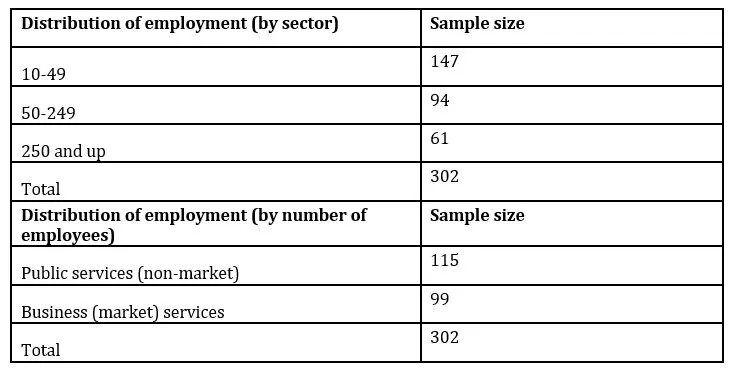
The survey was conducted on a selected group of enterprises from the private and public sector, excluding micro-enterprises. To achieve this goal, data collected in a nationwide survey of enterprises (n = 302) were used
Analysis of research findings
The analysis of the results of research on the entrepreneurial ecosystem and its elements in the context of digitization processes taking place in the economy and their impact on enterprises allowed for the formulation of general conclusions. They concern the ordering and assessment of the elements of the ecosystem occurring in the environment of enterprises – the hierarchy of importance of individual pillars in the process of digitization and digital integration in the business activity of enterprises. The EE elements that received the highest average indications (on a scale of 1-7) were, respectively: institutional support systems (e.g. regional development agencies, scientific and research networks) – 4.5, government policy and legal regulations – 3.5 and financing (banks, funds, investors) – 3.4 (Fig.2). According to the average ratings, the following were indicated as the areas that have the greatest impact (indications of ratings from 5 to 7) on the level of digitization of business operations: government policy and legal regulations (27%), social networks (social media, the Internet) (12%) and education, courses and training (9.3%) (Fig.3). In addition to those mentioned above, the following areas were indicated as areas of significant impact: the labour market, financing (banks, funds, investors), norms and cultural environment. In the case of identifying areas that do not have and/or have a weak impact on the level of digitization (indications of grades from 1 to 4), the following institutions were generally indicated: i.e. universities and entities transferring knowledge to the economy (50%), institutional support systems (e.g. regional development agencies, scientific and research networks) – (48%) and business organizational cooperation networks (e.g. business contacts, guilds, chambers, professional corporations) and sales markets (44%).
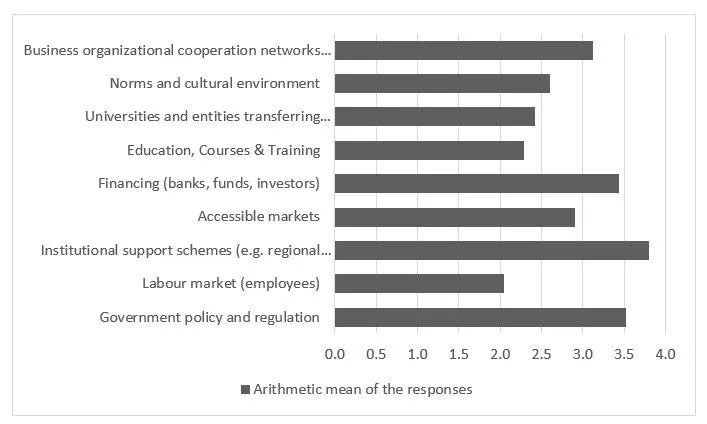 Fig.2. Ratings of the entrepreneurial ecosystem elements
Fig.2. Ratings of the entrepreneurial ecosystem elements
Source: Authors’ own eleboration.
A study carried out on the sector of companies operating on the market in various sectors and sections indicates that these elements are not yet well identified (Fig.3). The largest number of indications concerned one pillar – government policy and legal regulations at a level of up to 30%. The remaining elements did not exceed the number of indications above 15%. None of the respondents gave any other example of a network, relationship, or institution that could strengthen or expand the size of the ecosystem.
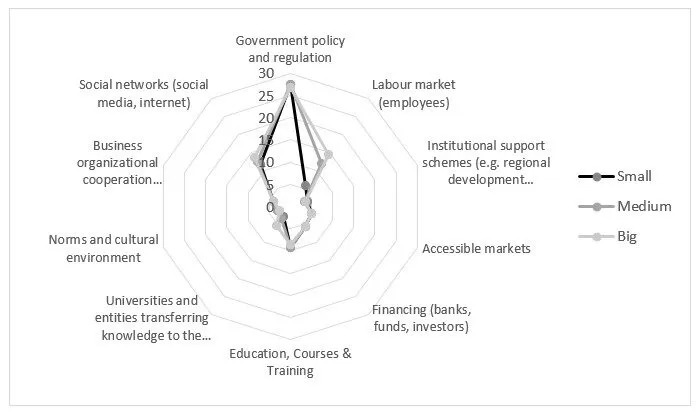
Fig 3. Elements of the entrepreneurial ecosystem in the digitization of the economy in percentage (assessment of enterprises by size)
Source: Authors’ own study.
For small businesses, in addition to regulatory issues, education and upskilling in various forms of education, as well as social media and the Internet are also highlighted elements in the entrepreneurial ecosystem. Medium-sized enterprises indicated the labor market and employee skills in second place, and social media and the Internet in third place (Czaja 2024). In large enterprises, these elements were indicated in reverse order: social media and the Internet in second place, and the labor market in third place in terms of the importance of the ecosystem for digitization processes. In the case of the financing element (broadly defined as available sources of external financing – banks, funds, investors), it was indicated by 5.6% of enterprises in all sectors (SMEs and large ones) in fifth place. Its importance was also indicated more often by trade and production enterprises, and to a lesser extent by service enterprises.
The economic sectors of education and health care had the greatest EE element (government policy and regulation) signal, at 6.0 (Fig. 4). Education and healthcare were the two economic sectors with the lowest EE element indicator, at 1.0. This convergence could be explained by the fact that both sectors are funded by public monies from the national health fund or the state budget and are part of the public sector. Fascinatingly, the ecosystem element designated as Education, Courses & Training, had a high reading (5.2) from the Education sector. Two components of EE have been identified in the case of the section: production and processing at a considerable level: accessible markets at level 4.1 and government policy and regulation at level 3.8. In the Entertainment sector, a high reading of 5.7 was noted for social networks (Internet, social media). At the level of 3.8 (accessible markets) and 3.9 (financing factor), respectively, the trade and transportation sections showed the highest indicators.
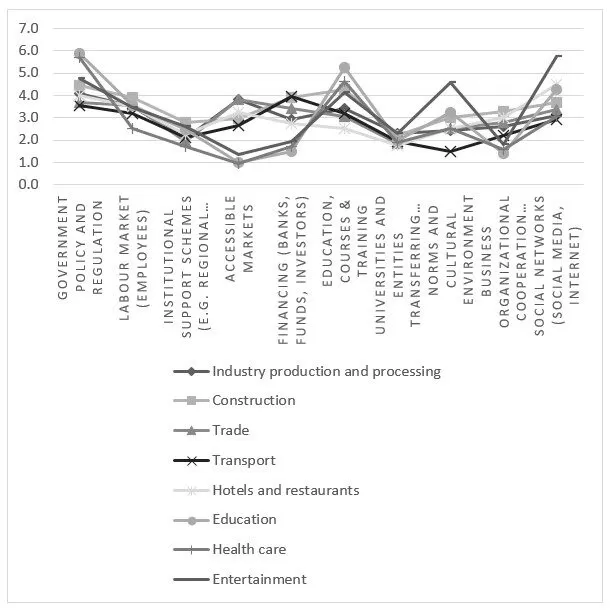 Fig.4. The importance of ecosystem elements for digitization processes taking place in small, medium and large enterprises
Fig.4. The importance of ecosystem elements for digitization processes taking place in small, medium and large enterprises
Source: Authors’ Own elaboration
In Q.2, the greatest consensus among the surveyed companies was on the issue of engaging (hiring/collaborating) skilled employees who understand the need for change and digitalization (Q2.3) and a shared vision and opportunity for growth in digitalization shared by partners, suppliers and customers (Q2.2). This indicates the existence of a synergistic effect between the cooperating companies and their partners and customers.
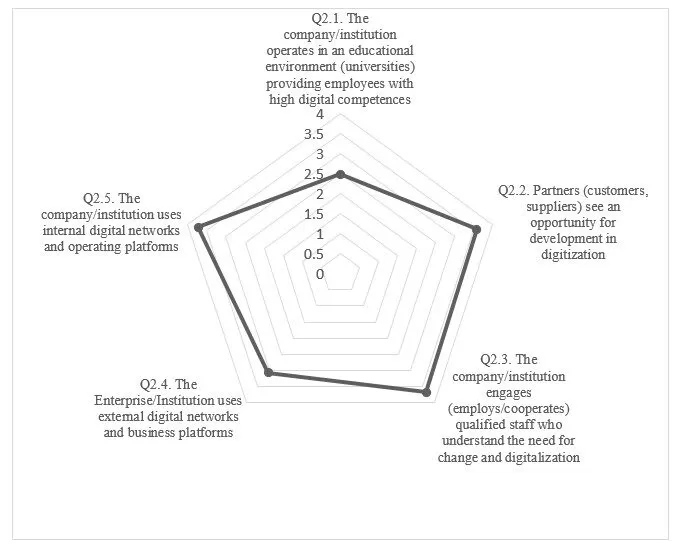
Fig.5. Assessment of the elements of the entrepreneurial ecosystem creating conditions conducive to the introduction of digital transformation in the surveyed enterprises by size (arithmetic mean of the responses)
Source: Authors’ own study.
Greater discrepancies in the responses of companies of different sizes can be seen in the assessment of individual statements contained in the second question (Fig. 5). The benefits of functioning in an educational environment (universities) providing employees with appropriate qualifications and knowledge (Q2.1) are indicated by 38% of small, 54% of medium-sized enterprises, and by 33% of large companies. The possibility of digital integration in business is seen in cooperation with partners (Q2.2) by 71% of small, 54% of medium-sized enterprises, and 41% of large companies, respectively. This indicates that SMEs have flexibility in introducing digitization under the influence of micro-environment entities, i.e. suppliers and buyers, and focus rather on the microenvironmental opportunities. This result also coincides with the indications of the entrepreneurial ecosystem element in question P.1.10 – social networks (social media, Internet), where small and medium-sized enterprises indicated this area -11.5% and 12.5% respectively. The company engages (hires/cooperates) skilled employees who understand the need for change and digitalization (P2.3) for 17% of small, 34% of medium-sized and 56% of large enterprises. The SME enterprises make little use of internal and external digital networks and platforms (P2.4 and P2.5 – 15% and 12% respectively), while 54% of large companies use external Internet infrastructure and platforms, and 72% use internal digital networks and operating platforms.
Summary
We may make a number of observations about the idea of entrepreneurship and its ecosystem by reviewing the recent literature. Traditional regional and local policies have clearly changed over the past three decades to encourage entrepreneurship and the general growth of innovation. Meanwhile, the emphasis on encouraging individual entrepreneurship has changed. The vocabulary pertaining to the components, assets, connections, and objectives of the entrepreneurship and innovation ecosystem is attempted to be arranged. The absence of subjective components, such as businesses and entrepreneurs, in the concept of the entrepreneurial ecosystem is another significant problem. According to the findings of studies conducted on the industry of businesses that operate in many sectors and areas, these factors are still little understood. At a level of up to 30%, the majority of signals focused on one pillar: laws and government policy. The remaining elements did not exceed the number of signals above 15%. Education and upskilling in many forms of education, as well as social media and the Internet, are vital for small firms in addition to regulatory difficulties. Social media and the Internet came in third, followed by the labor market and staff skills, according to medium-sized businesses. These factors were listed in reverse order of importance for digitization processes in large enterprises: the labor market came in third, followed by social media and the Internet. The results of the conducted research clearly indicate the main role of state policy in strengthening digitization processes. Regardless of the size and industry sector in which the companies operated, the importance of government policy and legal regulations enforcing the use of specific digital communication technologies, accounting, payroll and tax settlement systems, commercial, training and educational platforms was indicated in the first place. The possibility of digital integration in business is seen in cooperation with partners by the majority of the SME sector. This indicates that SMEs have a flexibility in introducing digitization under the influence of micro-environment entities, i.e. suppliers and buyers and focus rather on the microenvironmental oportunities. Further research on the ecosystem and its structure should also take into account the role of enterprises in the functioning of the ecosystem as a whole.
Acknowledgment
Through a subsidy given to the University of Economics in Krakow, the Ministry of Science and Higher Education co-financed the publishing.
References
- Aeeni Z., Motavaseli M., Sakhdari K. and Dehkordi A.M. (2019), ‘Baumol’s theory of entrepreneurial allocation: A systematic review and research agenda’, European Research on Management and Business Economics, Volume 25, Issue 1, 30-37. Available at: https://doi.org/10.1016/j.iedeen.2018.09.001.
- Baumol W. (1993) Entrepreneurship, Management and the Structure of Profit, MIT Press, London.
- Baumol, W. (1990) Entrepreneurship: Productive, Unproductive, and Destructive. Journal of Political Economy, 98(5), 893–921.
- Blew, R. D. (1996) ‘On the Definition of Ecosystem’, Bulletin of the Ecological Society of America, 77(3), 171–173. Available at: https://www.researchgate.net/publication/331464563_On_the_definition_of_ecosystem
- Brown, R. and Mason, C. (2017). ‘Looking inside the spiky bits: a critical review and conceptualisation of entrepreneurial ecosystems’, Small Business Economy, 49, 11–30. Available at: DOI 10.1007/s11187-017-9865-7
- Brown, R and Mason, C. (2014), ‘Entrepreneurial ecosystems and growth oriented entrepreneurship. Paris: Final Report to OECD, 30, 77-102.
- Budden, P. and Murray, F. (2017) ‘A systematic MIT approach for assessing ‘innovation-driven entrepreneurship’in ecosystems (iEcosystems)‘, Working paper published by MIT’s Laboratory for Innovation Science & Policy, 36.
- Buła, P. and Schroeder, T. (2020) ‘Selected aspects of the co-evolution of the Polish entrepreneurial ecosystem’, Organization Review, No. 10(969), 20-27. Available at: DOI: 10.33141/po.2020.10.03.
- Carayannis E.G, Barth T.D. and Campbel D.F. (2012) ‘The Quintuple Helix innovation model: global warming as a challenge and driver for innovation’, Journal of Innovation and Entrepreneurship. Available at: http://www.innovation-entrepreneurship.com/content/1/1/2
- Carayannis, E. G., Grigoroudis E. and Wurth B. (2021). ‘OR for entrepreneurial ecosystems: a problem-oriented review and agenda’, European Journal of Operational Research, 300, 791–808.
- Carayannis, E. G., and Campbell, D. F. (2022) ‘Towards an Emerging Unified Theory of Helix Architectures (EUTOHA): Focus on the Quintuple Innovation Helix Framework as the Integrative Device. Triple Helix – aspects of the co-evolution of the Polish entrepreneurial ecosystem’, Organization Review, No. 10(969), 20-27. Available at: https://doi.org/10.1163/21971927-bja10028
- Carrol G.R. (1984) ‘Organizational Ecology’, Annual Review of Sociology, No 10, 1–93.
- Clements, F.E. and Pound, R (1898). ‘A method of determining the abundance of secondary species’, Minnesota Botanical Studies, 2, 19–24.
- Czaja I. (2024), Elements of Entrepreneurial Ecosystem in Business Digitalization: Empirical Polish SME Study in: Empower Businesses and Create Economic Development in Digital Future: Vision 2030, Khalid S. Soliman (ed.). Proceedings of the 44th International Business Information Management Association Conference (IBIMA), 27-28 November, 1120-1132.Czaja I. and Kafel T. (2022). Shaping Relationships With Business Environment in Entrepreneurial University in: Science, Business and Universities: Cooperation, Knowledge Transfer and Entrepreneurship, ed. Joanna Duda, Tomasz Bernat, New York Abingdon, Oxon, Routledge, 146-159.
- Digital Economy and Society Index (DESI) for 2022. Poland (2024) Digital Strategy, European Commision. Available at: https://digital-strategy.ec.europa.eu/pl/policies/desi-poland
- Digitization of the SME sector in Poland (2023) Związek Przedsiębiorców i Pracodawców, October 2023. Available at: https://zpp.net.pl/wp-content/uploads/2023/11/02.11.2023-Raport-Cyfryzacja-sektora-MSP-w-Polsce.pdf
- Digitization of the SME sector. Chances and Barriers (2024), Departament for Research and Analysis, BGK, February. https://www.bgk.pl/aktualnosc/cyfryzacja-w-sektorze-msp-szanse-i-ograniczenia-raport-z-badania-bgk/
- Eesley, Ch.E. and Roberts, E. B. (2009). Entrepreneurial Impact: The Role of MIT (February 1, 2009). Available at: http://dx.doi.org/10.2139/ssrn.1352633
- Feld, B. (2012) Startup communities: Building an entrepreneurial ecosystem in your city. Hoboken, NJ., John Wiley.
- Fredin, S., and Lidén, A. (2020), ‘Entrepreneurial ecosystems: towards a systemic approach to entrepreneurship?’, Geografisk Tidsskrift-Danish Journal of Geography, 120(2), 87–97. Available at: https://doi.org/10.1080/00167223.2020.1769491
- Granstrand, O. and Holgersson, M. (2020), ‘Innovation ecosystems: A conceptual review and a new definition’, Technovation, Technovation Volumes, 90–91, February–March, Available at: https://www.sciencedirect.com/science/article/pii/S0166497218303870
- Hannan M.T. and Freeman J. (1977), ‘The Population Ecology of Organizations’, American Journal of Sociology, Vol. 82, No. 5 (March), 929-964.
- Hatch, M. J. (1993). The Dynamics of Organizational Culture. The Academy of Management Review, 18(4), 657–693. Available at: https://doi.org/10.2307/258594
- Isenberg, D. (2011). The Entrepreneurship Ecosystem Strategy as a New Paradigm for Economic Policy: Principles for Cultivating Entrepreneurship, Babson College: Babson Entrepreneurship Ecosystem Project. Available at: http://www.innovationamerica.us/images/stories/2011/The-entrepreneurship-ecosystem-strategy-for-economic-growth-policy-20110620183915.pdf
- Jafarov, N. and Szakos, J. (2022). ‘Review of entrepreneurial ecosystem models’, ASERC Journal of Socio-Economic Studies, 5(1), 3-16. Available at: DOI:10.30546/2663-7251.2022.5.1.3
- Ketonen-Oksi, S. and Valkokari, K. (2019). ‘Innovation Ecosystems as Structures for Value Co-Creation’, Technology Innovation Management Review, No 9, 24-34. Available at: DOI:10.22215/timreview/1216
- Klepper, S. and Miller J. H. (1995). ‘Entry, exit and shakeouts in the United States in new manufactured products’, International Journal of Industrial Organization, No. 13
- Lee, K. (2024). Economics of technology cycle time (TCT) and catch-up by latecomers: Micro-, meso-, and macro-analyses and implications. Journal of Evolutionary Economics, No 34, 319–349 Available at: https://doi.org/10.1007/s00191-024-00847-9
- Leendertse, J., Schrijvers, M. and Stam, E. (2021). ‘Measure Twice, Cut Once: Entrepreneurial Ecosystem Metrics’, Research Policy, art. no. 104336 https://www.sciencedirect.com/science/article/pii/S0048733321001359?via%3Dihub#bib0106
- Levitt T. (1965). ’Exploit the Product Life Cycle’, Harvard Business Review, No 11.
- Mack, E., and Mayer, H. (2016). ‘The evolutionary dynamics of entrepreneurial ecosystems’, Urban Studies, 53(10), 2118–2133. Available at: https://doi.org/10.1177/0042098015586547
- Malecki, E. J. (2018) ‘Entrepreneurship and entrepreneurial ecosystystems’, Geography compass, 12(3). Available at: DOI: 1111/gec3.12359
- Monitoring Industrial Ecosystems. Conceptual, Monitoring and Indicator Framework (2023). Available at: https://monitor-industrial-ecosystems.ec.europa.eu/sites/default/files/2023-12/EMI%20Methodological%20Report.pdf
- Moore, J. F. (1993) ‘Predators and Prey: A New Ecology of Competition’, Harvard Business Review, 71:3, 75-86.
- Moore, J.F. (1996) ‘The Death of Competition: Leadership and Strategy in The Age of Business Ecosystems’, Harper Business. Available at: https://www.researchgate.net/publication/31744644_The_Death_of_Competition_Leadership_and_Strategy_in_the_Age_of_Business_Ecosystems_JF_Moore
- Moore, J.F. (2006) ‘Business ecosystems and the view of the firm’, The Antitrust Bulletin, March. Available at: DOI: 10.1177/0003603X0605100103
- Muldoon, J., Liguori, E.W., Solomon, S. et al. (2023). Technological Innovation and the expansion of Entrepreneurship Ecosystems. Rev Managment Science, 17, 1789–1808. Available at: https://doi.org/10.1007/s11846-022-00573-1
- Naudé, W. (2023). Destructive Digital Entrepreneurship. IZA – Institute of Labor Economics. Available at: http://www.jstor.org/stable/resrep57397
- Normann, R. and Ramírez, R. (1993), ‘From value chain to value constellation: designing interactive strategy’, Harvard Business review, 71(4), 65-77.
- North D.C. (1990) Institutions, institutional change and economic performance. Cambridge
University Press, New York.
- OECD (2011). Raport New Models for Entrepreneurship. Available at: https://reports.weforum.org/new-models-for-entrepreneurship/executive-summary/
- Rotschild M. (1990) Bionomics: Economy as Ecosystem. New York, Henry Holt and Company.
- Rotschild M. (2004) Bionomics: Economy as Business Ecosystem, Beard Books, Washington D.C.
- Ruohomaa, H. (2022) ‘Ecosystem-based development in the transition of fourth industrial revolution’, Acta Wasaensia, No 452. Available at: https://osuva.uwasa.fi/bitstream/handle/10024/11584/978-952-476-931-0.pdf?sequence=2
- Shwetzer, C., Maritz, A. and Nguyen, Q.(2019), ‘Entrepreneurial ecosystems: a holistic and dynamic approach, Journal of Industry – University Collaboration, Vol. 1:2, 79-95. Available at: https://doi.org/10.1108/JIUC-03-2019-0007
- Soto, J.H. de (2010). Socialism, Economic Calculation and Entrepreneurship, Edward Elgar Cheltenham, UK, Northampton, MA, USA. Available at: https://iea.org.uk/wp-content/uploads/2016/07/HUERTA%20EBOOK.pdf
- Soto, J.H. de (2008). The Theory of Dynamic Efficiency, Routlege. DOI: 10.4324/9780203930601.
- Spigel, B. and Stam E. (2018), Entrepreneurial ecosystems, SAGE Handbook of Entrepreneurship and Small Business, R Blackburn, D. De Clercq and J Heinonen (eds), SAGE, 21, London. Available at: https://doi.org/10.4135/9781473984080.n21
- Stam, E. (2015) ‘Entrepreneurial Ecosystems and Regional Policy: A Sympathetic Critique’, European Planning Studies, 23: 9, 1759-1769.
- Stam, E. (2018) Measuring Entrepreneurial Ecosystems. Entrepreneurial Ecosystems. International Studies in Entrepreneurship, O’Connor, A., Stam, E., Sussan, F., Audretsch, D. (eds), vol 38. Springer, Cham. Available at: https://doi.org/10.1007/978-3-319-63531-6_9
- Stam, E., van de Ven, A. (2021), ‘Entrepreneurial ecosystem elements’,Small Business Economics, 56, 809–832. Available at: https://doi.org/10.1007/s11187-019-00270-6
- Sussan, F. and Acs, Z. (2017) ‘The Digital Entrepreneurial Ecosystem’, Small Business Economics, 49, 55–73.
- Tansley, A. G. (1935) ‘The use andabuse of vegetational conceptsand terms’, Ecology, 16, 284-307.
- Theodoraki, Ch., Dana, L-P. and Caputo A. (2022), ‘Building sustainable entrepreneurial ecosystems: A holistic approach’, Journal of Business Research, Volume 140, 2022, p. 346-360. Available at: https://doi.org/10.1016/j.jbusres.2021.11.005.
- Trubnikov D. (2021) ‘What entrepreneurship is really “productive”? An alternative view on Baumol’s typology’, Journal of Business Venturing Insights, Volume 16. Available at: https://doi.org/10.1016/j.jbvi.2021.e00258.
- Valkokari, K. (2015). Business, Innovation, and Knowledge Ecosystems: How They Differ and How to Survive and Thrive within Them, Technology Innovation Management Review, 5(8), 17-24. Available at: http://doi.org/10.22215/timreview/919
- Van de Ven, H. (1993) ‘The development of an infrastructure for entrepreneurship’, Journal of Business Venturing, 8(3), 211-230.
- WEF (2014). Entrepreneurial ecosystems and around the globe and early-stage company growth dynamics—an entrepreneurs perspective. Davos: World Economic Forum. Available at: http://www3.weforum.org/docs/WEF_II_EntrepreneurialEcosystemsEarlyStageCompany_Report_2014.pdf.
- Wurth B., Stam E., Spigel B. (2023), “Entrepreneurial Ecosystem Mechanisms”, Foundations and Trends in Entrepreneurship, Vol. 19, No. 3. Available at: http://dx.doi.org/10.1561/0300000089



